|
 Secure Site
Secure Site
|
 |
Archive for the 'mindfulness practice' Category
 How do you make time for what matters most? Now & Zen, Inc., based in Boulder, Colorado, is an Alarm Clock Company founded in 1995 by artist and entrepreneur Steve McIntosh. Now & Zen’s mission is to participate in the emerging movement in society toward a more spiritually focused lifestyle. Our shorthand way of describing this lifestyle is “quality of thought and stillness of being”. These complimentary aspects of spiritual living are described below.
Quality of thought
The idea of quality of thought applies to the holistic or “integral” perspective by which we consider the full impact of our choices and actions. Quality thinking is value driven and concerned with the welfare of the greatest relevant whole—our whole selves, our whole environment, and our whole society. Quality of thought is another way to refer to the practice of the “golden rule”—our concern for the common good.
Quality of thought also embraces the insights of cutting edge science as well as ancient wisdom from diverse traditions. While a spiritual lifestyle extends far beyond “thought,” we must use our minds to recognize the movement of spirit in the world. Now & Zen’s Alarm Clocks embody quality of thought through their use as tools for education and transformation, in the esoteric principles used in their design, and in their beauty and originality.
Stillness of Being
 v Perhaps the most important aspect of spiritual living is feeling the presence of the Sacred, however we define it. Cultivating a stillness practice such as meditation or prayer can be a powerful way to feel the presence of spirit. Stillness of being is also about inner peace and faith in a higher power. Just as quality of thought is about seeking for truth—the yang aspect of a spiritual life, stillness of being involves the yin principle of receptivity. It is in the state of stillness that the blessings of spirit are most fully received.
Now & Zen products embody stillness of being by helping to reduce stress and through the use of images of peace, such as the raked sand from a Zen garden and similar peaceful images used for our clock dial faces.
Ultimately, a spiritual lifestyle can be defined as any path that leads to spiritual experience. And as we understand it, spiritual experience is about beauty, truth and goodness. We thus strive to bring quality of thought and stillness of being to all Now & Zen products by making each one beautiful, true, and good: Every Now & Zen’s Alarm Clocks are designed to be beautiful to the eye and ear; all of our product claims are true—scientifically accurate and philosophically reasonable; and all of our products are “good for something,” that is, useful in our daily lives and not merely decorative or symbolic.
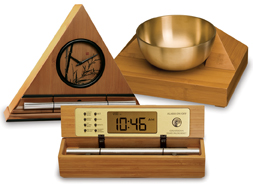 quality of thought, stillness of being Now & Zen Headquarter Store
1638 Peal Street
Boulder, CO 80302
(800) 779-6383
Posted in Goodness, mindfulness practice, Natural Awakening, Well-being
 energizing yoga It’s three o’clock, and despite your novel-length to-do list, the only thing that holds your attention longer than 30 seconds is the thought of a caffeine or sugar fix. You’d get a better and more sustained boost, though, by practicing a midday meditation.
Typically associated with relaxation, meditation also jump-starts energy and clears a foggy head, says Eric Harrison, director of Australia’s Perth Meditation Centre and author of “Flip the Switch: 40 Anytime, Anywhere Meditations in 5 Minutes or Less.” “If you meditate consciously and don’t succumb to sleep, your mind becomes calm and clear,” he explains. And unlike the usual drowsiness cures, a few minutes of meditation can keep you alert all afternoon.
One of Harrison’s favorite quick meditations involves tuning in to the sounds we generally try to ignore, which gives the chattering mind a chance to rest. So close your office door or find a quiet space and follow these easy steps — and that cafe run might soon be a thing of the past.
 yoga at work Listening Meditation
Clear a space. Set your Zen Meditation Timer for 5 minutes. Take a moment to remove some of the clutter in your immediate area — mugs, scattered pens, loose papers. This helps you transition into meditation mode and sets the stage for a calmer, more productive afternoon.
Log off. Turn off your computer and silence the ringers on your work and cell phones. This limits physical distractions while freeing up your mind to focus on listening.
Close your eyes and normalize your breathing. Sit up straight and take long, deep, deliberate inhalations, followed by even longer exhalations. Continue this breathing throughout the entire exercise.
Begin listening. Tune in to the sounds around you as if you were listening to music. Let your ears explore both background and foreground noises. Are there any sounds you can hear now that you didn’t before? What’s the most distant sound you can hear? What’s the closest? What music or harmonies do they create together?
Notice your mood. Suspend any judgments about the sounds that normally irritate you, like the hum of the copier, and just listen.
Check your body. Locate any tense feelings within, and concentrate on relaxing each one of them.
When you hear the Zen Meditation Timer Chime, after several minutes, open your eyes. Notice the difference in your energy level. If you’re still feeling groggy, distracted, or unfocused, continue the listening meditation for a minute or two more.
adapted from Body + Soul, June 2007 by Donna Garlough
 maple zen timer for meditation and yoga
Now & Zen
1638 Pearl Street
Boulder, CO 80302
(800) 779-6383
Posted in Bamboo Chime Clocks, intention, Meditation Timers, Meditation Tools, mindfulness practice, Now & Zen Alarm Clocks, Well-being
 meditation improves attention New research shows that meditation can help you improve your ability to concentrate in two ways. First, it can make you better at focusing on something specific while ignoring distractions. Second, it can make you more capable of noticing what is happening around you, giving you a fuller perspective on the present moment.
Some of the most fascinating research on how meditation affects attention is being conducted by Antoine Lutz, PhD, an associate scientist at the Waisman Laboratory for Brain Imaging and Behavior at the University of Wisconsin at Madison, in collaboration with Richard Davidson and the Laboratory for Affective Neuroscience at the University of Wisconsin. Their work has shown that concentration meditation, in which the meditator focuses complete attention on one thing, such as counting the breath or gazing at an object, activates regions of the brain that are critical for controlling attention. This is true even among novice meditators who receive only brief training. Experienced meditators show even stronger activation in these regions. This you would expect, if meditation trains the brain to pay attention. But extremely experienced meditators (who have more than 44,000 hours of meditation practice) show less activation in these regions, even though their performance on attention tasks is better. The explanation for this, in Lutz’s view, is that the meditation training can eventually help reduce the effort it takes to focus your attention. “This would be consistent with traditional accounts of progress in meditation practice. Sustaining focus becomes effortless,” Lutz says. This suggests that people can immediately enhance concentration by learning a simple meditation technique, and that practice creates even more progress.
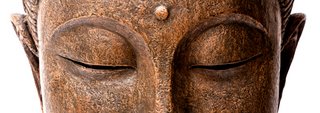 Buddha The researchers also looked at whether vipassana meditation training can improve overall attention. (Vipassana means “to see things as they really are,” and the meditation techniques are designed to increase focus, awareness, and insight.) Researchers label our inability to notice things in our environment as “attentional blink.” Most of us experience this throughout the day, when we become so caught up in our own thoughts that we miss what a friend says to us and have to ask her to repeat it. A more dramatic example would be a car accident caused by your thinking about a conversation you just had and not noticing that the car in front of you has stopped. If you were able to reduce your attentional blink, it would mean a more accurate and complete perception of reality—you would notice more and miss less.
To test whether meditation reduces attentional blink, participants had to notice two things occurring in rapid succession, less than a second apart. The findings, published in PLoS Biology, reveal that the meditation training improved the participants’ ability to notice both changes, with no loss in accuracy.
What explained this improvement? EEG recordings—which track patterns of electrical activity in the brain, showing precise moment-by-moment fluctuations in brain activation—showed that the participants allocated fewer brain resources to the task of noticing each target. In fact, the meditators spent less mental energy no-ticing the first target, which freed up mental bandwidth for noticing what came next. Paying attention literally became easier for the brain.
As a result, Lutz and his colleagues be-lieve that meditation may increase our control over our limited brain resources. To anyone who knows what it’s like to feel scattered or overwhelmed, this is an ap-pealing benefit indeed. Even though your attention is a limited resource, you can learn to do more with the mental energy you already have.
adapted from Yoga Journal, by Kelly McGonigal
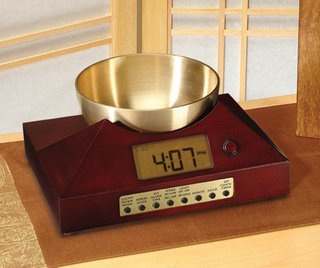 Zen Timepiece with brass singing bowl, a meditation timer Now & Zen
1638 Pearl Street
Boulder, CO 80302
(800) 779-6383
Posted in Bamboo Chime Clocks, intention, Meditation Timers, Meditation Tools, mindfulness practice, Now & Zen Alarm Clocks, Well-being, Yoga Timer
 morning meditation practice with meditation timer Sense the Stillness
You don’t have to be a regular yoga or meditation practitioner to reap the benefits of a morning meditation ritual. Start with five minutes daily, using the guidelines that follow. Then over the course of a few weeks — or when you are ready — gradually work up to 10 minutes. Remember, with meditation it’s quality, not quantity, that matters.
Start with awareness. Rather than lunge out of bed, Novie suggests waking up slowly. “Spend a few minutes just becoming conscious of the sensations of your body. Awareness is such a beautiful way of entering your day.” Once you’re up, resist the temptation to check your e-mail, flip on the radio, or do any of the other countless things that draw you out of yourself and into the concerns of the world. Instead, keep the focus inward.
Find a comfortable spot. Practice your five minutes of meditation anywhere you like (the bedroom floor, a favorite chair) except the bed, where you may fall back to sleep. Be sure to set your Singing Bowl Meditation Timer (Now & Zen, $199.95) for 5 minutes so that your session can end with a calm chime. To enhance the sacred aspect of her meditation space, Novie set up a small altar in her living room that she uses only for meditation, giving the space a positive energy of its own.
Sense your breath. Close your eyes. Feel your breath moving in and out of your body without controlling it. Bring your attention to the rise and fall of your abdomen or to the tip of your nose. The more awareness you bring to breath and body, the more grounded in your body you’ll become. This, in turn, will help relieve some of the stress that comes with getting through your morning.
Don’t try to block your thoughts. Your mind will wander — that’s what it’s designed to do. Rather than try to fight off thoughts as they emerge, acknowledge them, but don’t engage them. And give yourself some slack — meditation is, after all, a practice, not perfection.
For yoga instructor Alison Novie, mornings make an ideal time for meditation — perhaps more than any other time of day. “The sun’s about to rise, but it’s still sort of dark and quiet,” says Novie, who wakes at 5:00 a.m. to meditate. “I get up, brush my teeth, light a candle, and then sit for half an hour. The calm energy I get from that morning meditation carries me through the day.”
adapted from Body + Soul Magazine, March 2006
Our Singing Bowl Meditation Timer called The Zen Timepiece is an acoustic 6-inch brass bowl-gong clock. It is the world’s ultimate alarm clock, practice timer, and “mindfulness bell.”
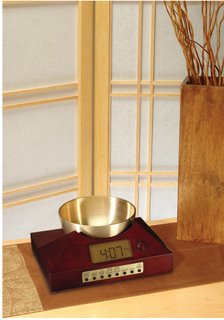 Singing Bowl Meditation Timer is Ideal for Morning Meditation Practice
Now & Zen’s Singing Bowl Meditation Timer Shop
1638 Pearl Street
Boulder, CO 80302
(800) 779-6383
Posted in Chime Alarm Clocks, Meditation Timers, Meditation Tools, mindfulness practice, Well-being, Zen Timers
 Meditation Practice, Stillness of Being For a formal practice to cultivate equanimity, begin with some calming breaths or a mantra meditation. Once you feel calm, reflect on your desire for happiness and freedom from suffering, both for yourself and for others. Contemplate your desire to serve the needs of others and to be compassionately engaged in the world. Acknowledge both the joy and the suffering that exist throughout the world—the good deeds and the evil ones. As you continue to breathe into your heart’s center, acknowledge the necessity of balancing your desire to make positive change in the world with the reality that you cannot control the actions of others.
Bring to mind the image of someone for whom you have no strong feelings one way or the other. With this person in your mind’s eye, repeat the following phrases to yourself, coordinating with the outbreath if you like:
- All beings like yourself are responsible for their own actions.
- Suffering or happiness is created through one’s relationship to experience, not by experience itself.
- Although I wish only the best for you, I know that your happiness or unhappiness depends on your actions, not on my wishes for you.
- May you not be caught in reactivity.
Feel free to use other similar, appropriate phrases of your own devising. After a few minutes, shift your attention to your benefactors, including teachers, friends, family and the unseen workers who keep the societal infrastructure working. Silently repeat the phrases to yourself as you contemplate these benefactors.
After several minutes, begin to reflect on your loved ones, directing the phrases to them, followed by the difficult people in your life. While feeling kindness, compassion, and joy for those we love comes more easily than it does for those with whom we have difficulty, it is often the opposite with equanimity. It’s a lot easier to accept that those we dislike are responsible for their own happiness than it is for those we care for deeply, because we feel more attachment to them. Whatever your experience, simply note any reactivity and see if you can be equanimous with your reactivity! Broaden your reach after a few minutes to include all beings everywhere throughout the world, and then finally contemplate equanimity in regard to yourself, noticing how taking responsibility for your own happiness and unhappiness can feel the hardest of all.
- All beings, including myself, are responsible for their own actions.
- Suffering or happiness is created through one’s relationship to experience, not by experience itself.
- Although I wish only the best for myself, I know that my happiness or unhappiness depends on my actions, not my wishes for myself.
- May I not be caught in reactivity.
adapted from Yoga Journal by Frank Boccio
Frank Jude Boccio is a teacher of yoga and Zen Buddhism and the author of Mindfulness Yoga. Find him at mindfulnessyoga.net.
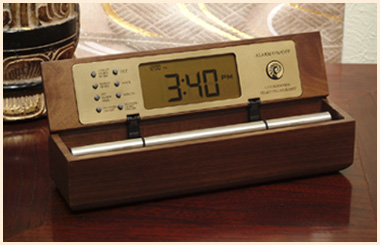 Meditation Timer for Your Meditation Practice The Walnut Digital Zen Clock’s long-resonating Tibetan bell-like chime makes waking up and meditating a beautiful experience – its progressive chimes begin your day with grace. When the clock’s alarm is triggered, the acoustic chime bar is struck just once … 3-1/2 minutes later it strikes again … chime strikes become more frequent over 10 minutes … eventually striking every 5 seconds until shut off. As they become more frequent, the gentle chimes will always wake you up or bring you out of your meditation. Your body really doesn’t need to be awakened harshly, with a Zen Clock you’re awakened more gradually and thus more naturally. Unlike artificial recorded sounds coming out of a tiny speaker in a plastic box, natural acoustic sounds transform your bedroom or office environment.
The Digital Zen Clock also serves as a countdown and interval timer for yoga, meditation, bodywork, etc.; and it can also be set to chime on the hour as a tool for “mindfulness.”
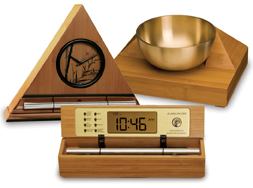 Find the Entire Family of Meditation Timer and Gongs at Now & Zen's Store in Boulder Now & Zen’s Meditation Timer Store
1638 Pearl Street
Boulder, CO 80302
(800) 779-6383
Posted in intention, Meditation Timers, Meditation Tools, mindfulness practice, Well-being, Zen Timers
 Our Yoga Timer & Clock can be programmed to chime at the end of the meditation or yoga session or periodically throughout the session as a kind of sonic yantra. Study: Even a Cram Course in Meditation Helps Reduce Pain
Meditation might beat morphine as a painkiller, new research suggests. In a small study, healthy medical students attended four 20-minute sessions to train them in “mindfulness meditation,” based on techniques such as focusing on breathing and banishing of distracting thoughts. Before and after the training, participants underwent brain scans with a pad heated to a painful 120 degrees attached to the back of their leg. They reported a 40 percent decrease in pain intensity and a 57 percent reduction in pain unpleasantness following their training. Morphine and similar drugs typically reduce pain by about 25 percent. Meditation reduced activity in key pain-processing regions of the brain, according to findings published Wednesday in the Journal of Neuroscience. “We found a big effect,” study author Fadel Zeidan, a research fellow at Wake Forest Baptist Medical Center, said in a press statement. “This study shows that meditation produces real effects in the brain and can provide an effective way for people to substantially reduce their pain without medications.”
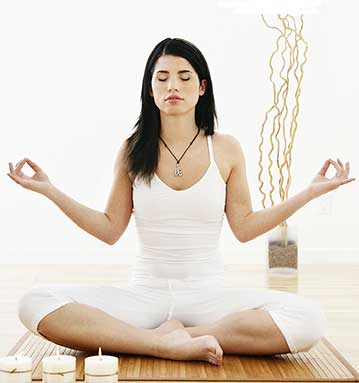 Bring Yourself Back to Balance Use our unique “Zen Clock” which functions as a Yoga & Meditation Timer. It features a long-resonating acoustic chime that brings your meditation or yoga session to a gradual close, preserving the environment of stillness while also acting as an effective time signal. Our Yoga Timer & Clock can be programmed to chime at the end of the meditation or yoga session or periodically throughout the session as a kind of sonic yantra. The beauty and functionality of the Zen Clock/Timer makes it a meditation tool that can actually help you “make time” for meditation in your life. Bring yourself back to balance.
By ANGELA HAUPT for US News
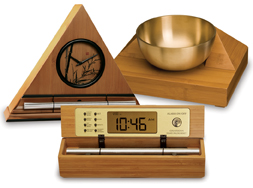 The beauty and functionality of the Zen Clock/Timer makes it a meditation tool that can actually help you "make time" for meditation in your life Now & Zen – The Chime Meditation Timer Store
1638 Pearl Street
Boulder, CO 80302
(800) 779-6383
orders@now-zen.com
Posted in Meditation Tools, mindfulness practice
 Once you experience the Zen Timepiece's progressive tones, you'll never want to meditate any other way. New research indicates chanting and meditation help enhance mind/body health and balance. A study by the University of California-San Diego, the Alzheimer’s Prevention Foundation International, and the Amen Clinic of Newport Beach, California, found that Kirtan Kriya, a simple twelve minute Kundalini yoga meditation, increased oxygen delivery, blood flow, and energy in the brain, while improving neurotransmitter (chemical messengers of the brain that communicate with the body) function.
Kirtan Kriya involves chanting the Sanskrit words ‘Sa’ (meaning birth or cosmos), ‘Ta’ (life), ‘Na’ (completion), and ‘Ma’ (signifying rebirth). Here’s how to practice it: Repeat ‘Sa Ta Na Ma’ with your eyes closed while sitting with a straight spine; focus your mental energy on the area between your eyebrows. For two minutes, chant in your normal speaking voice; for the following three minutes, whisper. For the next three minutes, chant silently. Then reverse the order; whispering for two minutes and chanting the mantra aloud for two minutes. Enjoy your enlightenment!
 It's exquisite sounds summon your consciousness out of your meditative state with a series of subtle gongs. Use our unique “Zen Clock” which functions as a Yoga & Meditation Timer. It features a long-resonating acoustic chime that brings your meditation or yoga session to a gradual close, preserving the environment of stillness while also acting as an effective time signal. Our Yoga Timer & Clock can be programmed to chime at the end of the meditation or yoga session or periodically throughout the session as a kind of sonic yantra. The beauty and functionality of the Zen Clock/Timer makes it a meditation tool that can actually help you “make time” for meditation in your life. Bring yourself back to balance.
adapted from Healinglifestyles.com by Kyle Roderick
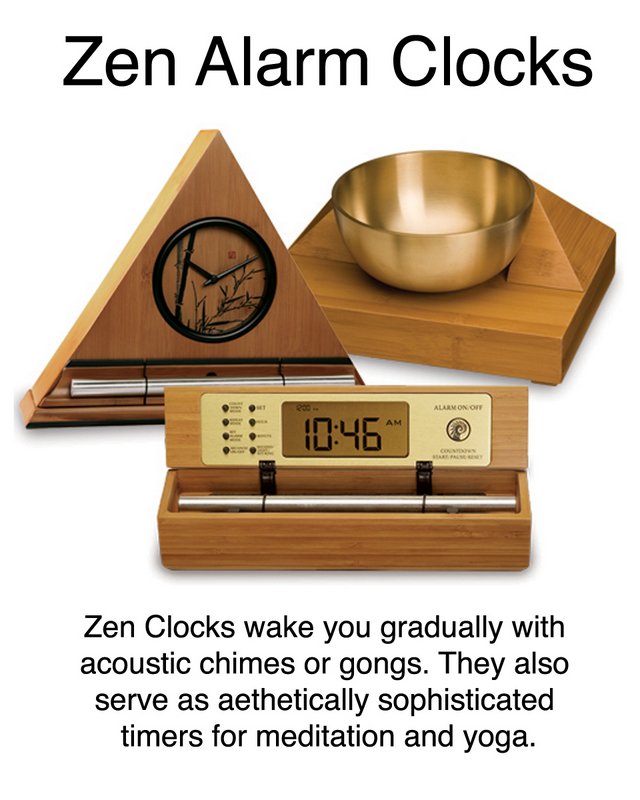 Zen Alarm Clocks, made by Now & Zen, Inc., come in a variety of shapes and sizes. Now & Zen – The Tibetan Singing Bowl Meditation Timer
1638 Pearl Street
Boulder, CO 80302
(800) 779-6383
orders@now-zen.com
Posted in Meditation Timers, Meditation Tools, mindfulness practice
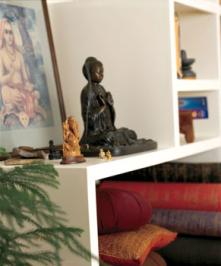 creating a meditation space in your home • It doesn’t really matter where your meditation space is located in your house, although Rodney Yee says the Balinese consider the northeast corner culturally and religiously auspicious. Tias Little likes the southeast corner because it captures morning light for early meditation. Basically, says Yee, pick a space where you feel relaxed and comfortable. “I think everybody has a special little place where they go to be quiet—just like a cat that searches until it finds the right spot to sleep.”
• You can think big thoughts in any size space. Your meditation area can be as expansive as Richard Freeman’s, a room “at the very top of the house, encompassed by a big maple tree,” or simply a spare closet or an empty corner. Rainbeau Mars likes a window for fresh air as long as it’s not distracting, but Little says a semi-enclosed space can give a “really spectacular feeling, like a little womb.” You might consider creating a six- or seven-foot-square adobe “cell” addition to your house or yard.
 meditation space • “Anyone can use [a meditation space], but only for meditation,” Deepak Chopra says. Freeman says to minimize distraction, you should choose a location that’s as isolated as possible from the traffic flow in your house, and it shouldn’t be in an area where you’re more tempted to sleep than meditate. If you share your space, each person should have his or her own chair, cushion, zabuton mat, or zafu pillow, “something that sanctifies this is my space,” Mars says. Sit on it only when you meditate. That helps create a ritual conducive to meditation, Judith Hanson Lasater says. It is nice to have a special Zen Meditation Timer on a table beside your the chair or cushion that you meditate on. This way you can easily reach the meditation timer to turn it off when it chimes and then you can continue to sit in peace until ready to move.
 Zen Timepiece, a brass singing bowl clock and timer • Tatami mats or bare wood floors are a better, cleaner option than rugs or carpets, and they create a more spacious feeling, Little says.
• An altar is a good idea. “When you set it up, the space begins to get that special feeling,” Yee says. An altar makes it clear the space is reserved for meditation and serves as a repository for your sacred objects and decorations. It needn’t be elaborate: Little has seen window sills used as altars. Yee’s altar is a small, low table covered with a Balinese cloth; Freeman’s is a stone slab.
• If you do yoga in your meditation space, store props such as mats, blocks, and straps in a chest. Leaving them out creates distracting clutter.
• Avoid bright overhead lighting, or use a dimmer switch. Lamps or sconces are best because they combine illumination with warmth.
• Include a timer. Meditation is all about discipline and consistency, and meditating a set amount of time each day can help achieve that, Lasater says. The Zen Timepiece chimes gently at the end of one’s meditation without startling one back to the here and now.
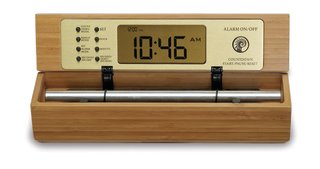 Bamboo Zen Meditation Timer • Even experts disagree on how to decorate your space. Most are minimalists. “It needs to be elegant in its simplicity and with very little clutter,” Chopra says. His recommended decorations include candles, books, and symbolic representations of archetypal figures such as gods, goddesses, angels, flowers, incense, and pastel colors. “You should not include anything that symbolically represents violence,” he adds. Yet not everyone finds minimalism calming, points out Freeman. “Some people display every saint they’ve ever heard of; some people may have only one. Others might light a candle; others prefer nothing. It’s whatever makes you want to sit there and do nothing.”
adapted from Natural Home Magazine, Jan/Feb 2005 by Vicky Uhland
Posted in Bamboo Chime Clocks, Japanese Inspired Zen Clocks, Meditation Timers, Meditation Tools, mindfulness practice, Well-being, Zen Timers
 Try a Listen Meditation as a Mindfulness Practice Listening Meditation
Instructor Sally Kempton is a spiritual guide who teaches yoga and meditation at her Carmel, Calif.-based Awakened Heart Meditation (sallykempton.com). She authored The Heart of Meditation under her monastic name Swami Durgananda.
What is it? While many meditation techniques require solitude and silence, this one has you engage with the sounds all around you; it invites you to work with and use the noise instead of fighting it. Listening meditation also encourages you to harmonize with your surroundings, and, by extension, the universe. The intent is to experience sound as vibration, rather than information. The listening practice is a way of interacting with the environment that allows you to take in the whole energy of the present moment, says Kempton.
What’s it good for? Especially adaptable and portable, listening meditation can be practiced in crowded, noisy situationson a bus, at the office that would be hard on other styles. (Kempton once led a listening meditation workshop in the middle of a busy Whole Foods store!) People with particularly chattering minds may need to couple this practice with a mantra or breathing meditation. However, many people welcome the chance to focus outward rather than inward and find that listening meditation is one of the easier techniques to undertake. You’ll come away from it feeling refreshed, expanded, and at ease with your environment, declares Kempton.
How long does it take? Try for five minutes at first, then add a minute or two until you can do it for 15 or 20 minutes at a time. Set your Chime Meditation Timer by Now & Zen for five minutes and then increase as you get better at this practice.
How Do I Do It?
1. Set your Meditation Chime Timer for 5 minutes (increase the minutes as you improve). Sit in a comfortable position and close (or half close) your eyes.
2. To get centered and quiet the mind, first bring your awareness to your breath, noticing but not trying to change it.
3. Now open your ears and bring your awareness to the sounds around you. The goal is to listen to the whole range of sounds, without favoring one over another and without identifying them. Hear the quiet sounds and the silences as well as the dominant sounds.
4. When you find yourself identifying sounds (there’s a fire engine; thats the cat scratching the rug), gently redirect your attention from listening to a specific noise back to hearing the whole spectrum of sounds.
5. To end, slowly open your eyes, stand, and carry this heightened awareness with you for as long as you can.
Tip: Do a one-minute mini-listening meditation while standing in line or sitting at your desk, or anytime you feel frazzled: Close your eyes, breathe, and listen to the sounds around you. Like the practice of counting to 10 when you’re in the heat of an argument, this will help you pause, center, and regroup.
 Zen Meditation Timers, The Digital Zen Alarm Clock in Solid Walnut adapted from Natural Health Magazine
Now & Zen’s Chime Time Store
1638 Pearl Street
Boulder, CO 80302
(800) 779-6383
Posted in Bamboo Chime Clocks, Chime Alarm Clocks, intention, Meditation Timers, Meditation Tools, mindfulness practice, Well-being, Zen Timers
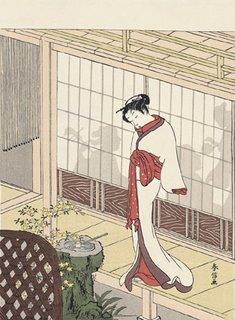 Harunobu Suzuki, Beauty at the Veranda - Choose a gentle chime meditation timer by Now & Zen You’re aiming for stimulated and focused—but not frazzled
Raleigh, N.C., businessman Buddy Howard used to feel his heart race and dread set in every time he thought about driving up profits at his equity research firm or was faced with an unwieldy project that seemed impossible to complete. Then his 11-year-old daughter developed anorexia—and he suddenly learned the difference between stress and stress. “Nothing comes close to the stress you feel as a parent when you’re afraid that your child is going to die,” says the 50-year-old father of two, who, seven years later, gets energized by the same deadline crunches that used to paralyze him. He now breaks large projects into discrete tasks that provide daily victories—the same bite-by-bite, pound-by-pound process his daughter used to overcome her eating disorder. And he’s altered his perspective on bigger earnings, focusing on the rush of the challenge and blotting out the fear of failure.
Stress has certainly earned its bad reputation, given the wreckage it causes: headaches, stomach pain, high blood pressure, insomnia, and mind freeze reminiscent of a crashing laptop. But it also has an unheralded upside. In normal doses, adrenaline and other “fight or flight” hormones improve performance and seem to even protect health. They increase alertness and motivate you to get things done by quickening your heartbeat, improving blood flow to the brain, and enhancing vision and hearing. And in small amounts, studies suggest, they boost the immune system and may protect against age-related memory loss by keeping brain cells active. University of Texas researchers recently found that those engaged in challenging and creative work enjoy better health—an advantage equivalent to being nearly seven years younger. “Your goal shouldn’t be to get rid of stress,” contends Esther Sternberg, a researcher at the National Institutes of Health and author of The Balance Within: The Science Connecting Health and Emotions. Rather, she says, you should aim for “the appropriate stress response.”
Extremely agitated. Getting the calibration just right can be tough, but it’s achievable: As Howard discovered, it’s often a matter of changing one’s perception of a challenge. Plenty of Americans have yet to figure out how. According to a recent survey by the American Psychological Association, nearly half say their level of stress has increased over the past five years, and fully one third routinely experience extreme agitation.
The problem with overwhelming stress? In the short term, the rush of stress hormones can make people less productive, even mentally paralyzed. Think writer’s block. When the overload becomes chronic, heart disease, depression, and an impaired immune system can result. An estimated 50 to 80 percent of people who develop depression have faced a major stressful life event, like a divorce or job firing, during the preceding three to six months and most likely have produced an excessive amount of the stress hormone cortisol. An October study published in the Journal of the American Medical Association found that heart patients battling chronic job strain were twice as likely as their more relaxed peers to have another heart attack. And researchers have been aware for some time that overanxious folks exposed to cold viruses are more apt to end up sick than those who aren’t.
“We think the system stops working appropriately when it’s constantly turned on,” says Sheldon Cohen, a professor of psychology at Carnegie Mellon University who first discovered the link between colds and stress. Chronically elevated cortisol levels lead to more colds and infections; depleted levels can cause an overactive immune system—and autoimmune diseases like rheumatoid arthritis.
 It's exquisite sounds summon your consciousness out of your meditative state with a series of subtle gongs. The ultimate goal is to hit a stress response appropriate for a given situation: You want to be in low gear when you’re, say, watching TV, medium when you’re doing car pool, and high—but not overdrive—when you’re under a deadline crunch. High gear is what Sternberg calls the peak of the “stress response rainbow,” or the point where you’re at your most productive, able to focus on the task at hand with minimal distractions. Most likely, you’re sent into this zone by an optimal level of adrenaline, cortisol, and other hormones that increase your pulse, reduce peripheral vision, and improve blood flow to the brain.
Biology undoubtedly plays a role in how easily you hit the target: A study published last year in the journal Cell found that mice that adapted poorly after being put in a cage with bigger, more aggressive mice produced larger amounts of stress-related brain chemicals than those that adapted well. But modifiable beliefs and expectations factor in, too. Expecting that your life will be unchanging, for example, is bound to make you react badly to dropping house values and a child’s academic reversals, says psychologist Robert Rosen, author of Just Enough Anxiety, a new book that explains how anxiety can be a key to success in the workplace. “Buddhists have this idea that every time we breathe, the world changes,” Rosen says. A philosophy of acceptance allows them to make peace with what they can’t control—like an earthquake, inflation, or an oppressive political regime.
 Once you experience the Zen Timepiece's progressive tones, you'll never want to meditate any other way. It serves as the perfect meditation timer. Playing tricks. Sometimes, Sternberg says, the trick “is to fool your brain into thinking that you have some degree of control.” Researchers have shown that people produce more healthful levels of stress hormones when they’re told they have control over a stressor, whether or not they actually act—they have the ability to press a button to stop a loud, irritating noise, say, even if they don’t stop the noise. It’s all about being proactive rather than placing blame—as much as we’d like to put it on our parents—or sitting back and feeling helpless.
You might find a way, for example, to limit your exposure to a stressor. Duke University stress researcher Redford Williams says he reduced his tension over having to deal with endless E-mail messages by simply deciding to stop constantly checking his PDA after hours. (Bonus: Ignoring the pesky E-mail eased a bit of stress in his marriage, too, he says, since he could tell from his wife’s body language that “it wasn’t good for our relationship.”)
Or you might take a break to exert your mastery in other areas. Daniel Lobring, a 29-year-old public relations manager from Chicago, restores his “I can deal” feelings by picking up his drumsticks. He finds that drumming helps relieve stress headaches triggered by the pressures of organizing high-profile events for athletes and clients like ESPN. “I can only send out so many press releases and photos,” he says, “and it’s stressful, waiting and hoping that whatever I did will get some media coverage.” With music, he explains, he knows his performance rests completely in his hands. Even in times of crushing catastrophes, people can find relief by doing something purposeful: donating blood or cash after 9/11 or the Chinese earthquake; buying energy-efficient light bulbs or a hybrid car to ease distress over global warming and rising gas prices.
Unless you’re a natural-born optimist, of course, you may really have to work at seeing possibilities when times are tough. “The way to become more resilient is to live in the world, challenging yourself socially, psychologically, and intellectually,” contends stress and resilience researcher Mary Steinhardt, a therapist and professor of health education at the University of Texas-Austin. In a study published in the January Journal of American College Health, she found that stressed-out college students who were given four weekly therapy sessions—focusing on coping strategies, self-esteem building, and making interpersonal connections—increased their “stress resilience,” a measure of how quickly they bounce back after feeling stressed, far more than peers who didn’t get the counseling.
Steinhardt suggests pausing when stress hits to simply recognize its source, whether it’s an unrealistic deadline, a family reunion, or an inflating mortgage. Focusing your attention on the problem is key to identifying what you can control and accepting what you can’t and topreventing a panicked reaction from developing unchecked. If you’re not in a panic, you can offer yourself some coaching: Is anger going to be productive? Are you really (choose one): a bad employee, the black sheep of the family, someone completely incapable of handling personal finances?
 Once you experience the Zen Timepiece's progressive tones, you'll never want to meditate any other way. It serves as the perfect meditation timer. Be Happy Without Being Perfect, argues that we need to retrain our brains to think realistically. She recommends keeping a journal detailing any perfectionist tendencies, what’s gained from them (a spotless house, perhaps), and what’s lost (the novel waiting on your nightstand).
The guilt has to go along with the outsize expectations. Feeling overwhelmed by the needs of her husband and two kids and the demands of her employee relations job at computer maker Dell, Tonja Eaton of Round Rock, Texas, says she learned to put her wants (free time on Sundays, family evenings at home, belly-dancing classes) over her shoulds (visits with relatives, birthday parties for her children’s acquaintances, serving on a charity board) after joining a monthly “personal renewal group” focusing on work-life balance issues. More than 150 of these groups, based on The Mother’s Guide to Self-Renewal by Renée Trudeau, have formed around the country. “I’ve discovered a lot of creative ways to say no,” says Eaton, 36. “I’ve learned to make it a rule that a minimum of 50 percent of weekends be spent at home. We’re much more connected as a family when we do that.”
Understressed. While the health hazards of too much stress have been well established, too little isn’t good for you either, according to Monika Fleshner, an associate professor of integrative physiology at the University of Colorado-Boulder who has conducted numerous studies on the stress response. It could be that if the stress system isn’t activated often enough, she theorizes, it produces higher levels of stress hormones when it does get turned on. Like a muscle, it may need to be used regularly in order to stay in peak working condition. This could explain why some people fall apart when hit by a serious crisis while others rise to the occasion. If your body isn’t used to having challenges, Fleshner speculates, “perhaps when the stress response finally does get turned on, it’s hard to turn off.”
More established are the daily psychological consequences that stem from a lack of challenge: boredom, low energy, and a reduced sense of accomplishment. Teresa Walden, 44, grew all too familiar with these feelings in the years after quitting her in-house-attorney position in Austin to raise her two sons. She assumed that going back to her position once her sons started school would restore her mojo, but instead she felt stymied by the same old work. Ultimately, Walden decided to become a life coach. “I definitely feel more energized, more alive with purpose and intention,” she says. “It makes me a better mom.”
Whether you’re bored or overwhelmed, reaching the optimal stress zone requires bridging the gap “between your current reality and your desired future,” says psychologist Rosen. “There’s the voice inside you that says take a leap, go forward, but there’s also the voice that holds you back, warning that it’s too risky.” His five-step plan for getting through the gap: Identify what you want to change; imagine your desired outcome; assess your current situation; analyze what it will take to get you to your future goal; and take action to get there, setting one small goal at a time.
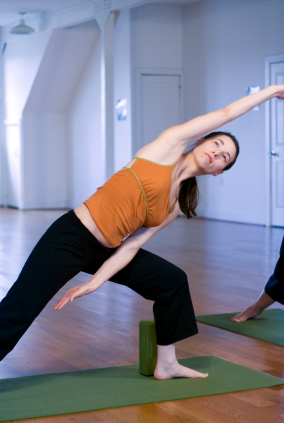 Yoga Stretch Try the cure-all. Beyond using your mental processes to manage your response to stress, there’s that terrific physiological tool: exercise. Regular physical activity is the single best thing you can do to gain energy if you’re understressed and to relax if you’re frazzled, say experts. A 2007 study published in the journal Psychosomatic Medicine found that people who exercise at least two or three times a week have smaller increases in blood pressure, heart rate, and inflammatory chemicals when given stressful word-naming tasks than those who never exercise.
Researchers now think that exercise triggers the release of “feel good” endorphins in the brain, one of which, enkephalin, is believed to prevent the release of excessively high levels of adrenaline and cortisol. A session of exercise also triggers the stress response—a plus for those who are underchallenged. If you’re having either a stressful or a low-energy day, head for the gym or squeeze in a 20-minute ultrabrisk walk, recommends Mark Hamer, an exercise physiologist at University College in London. You’ll get the biggest benefits within an hour after you work out.
Any treat that activates your brain’s pleasure centers—a massage, a piece of rich chocolate, a funny movie—can similarly dampen your stress levels. Novelty is what you’re shooting for if your stress levels are too low: Head to an amusement park, sign up for a challenging art class, or take a rafting trip down some rapids. With practice, you can get good at avoiding that “most useless place…for people just waiting…for a better break…another chance,” in the words of Dr. Seuss in Oh, the Places You‘ll Go! His advice: “When things start to happen, don’t worry. Don’t stew. Just go right along. You’ll start happening too.”
By DEBORAH KOTZ for US News
Although meditation can be done in almost any context, practitioners usually employ a quiet, tranquil space, a meditation cushion or bench, and some kind of timing device to time the meditation session. Ideally, the more these accoutrements can be integrated the better. Thus, it is conducive to a satisfying meditation practice to have a timer or clock that is tranquil and beautiful. Using a kitchen timer or beeper watch is less than ideal.
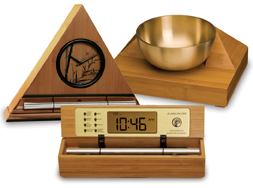 Once you experience the Zen Timepiece's progressive tones, you'll never want to meditate any other way. It serves as the perfect meditation timer.
And it was with these considerations in mind that we designed our digital Zen Alarm Clock and practice timer. This unique “Zen Clock” features a long-resonating acoustic chime that brings the meditation session to a gradual close, preserving the environment of stillness while also acting as an effective time signal. The Digital Zen Clock can be programmed to chime at the end of the meditation session or periodically throughout the session as a kind of sonic yantra. The beauty and functionality of the Zen Clock/Timer makes it a meditation tool that can actually help you “make time” for meditation in your life.
 It serves as the perfect meditation timer.
Posted in mindfulness practice
« Previous Page — « Previous Entries
Next Entries » — Next Page »
|
|
|
|